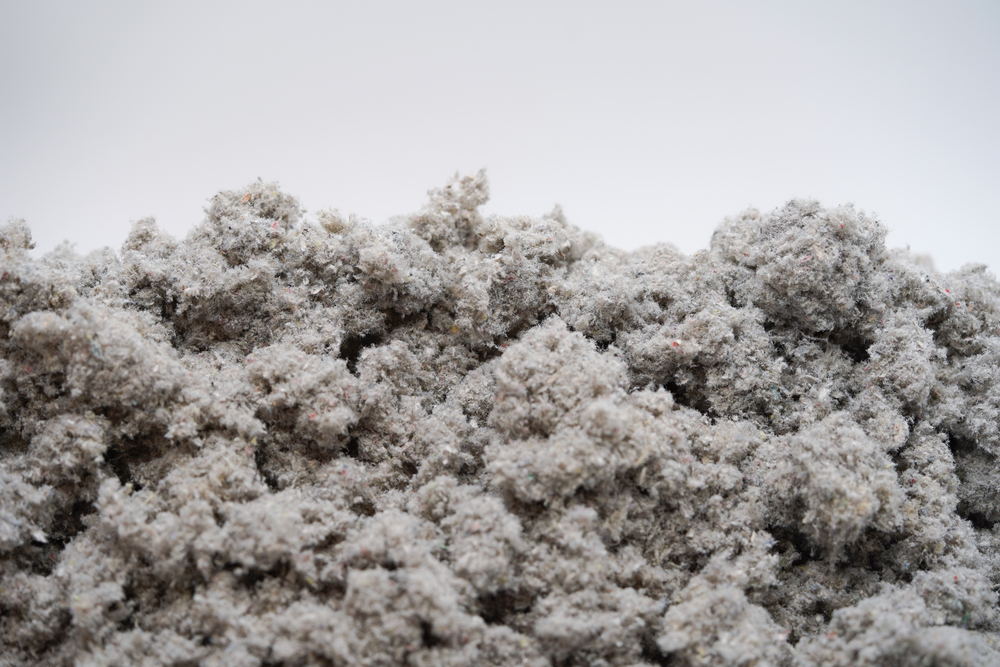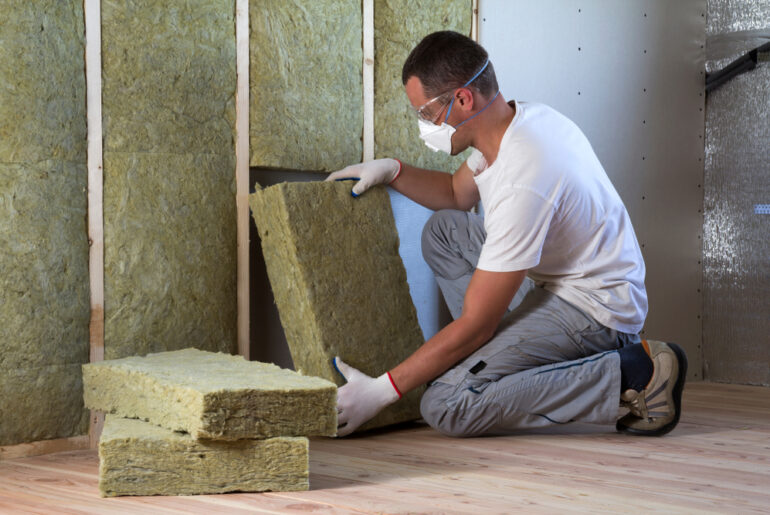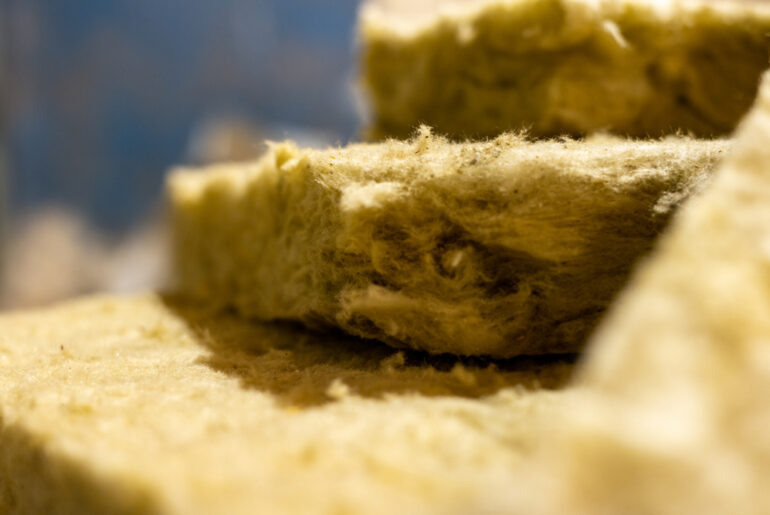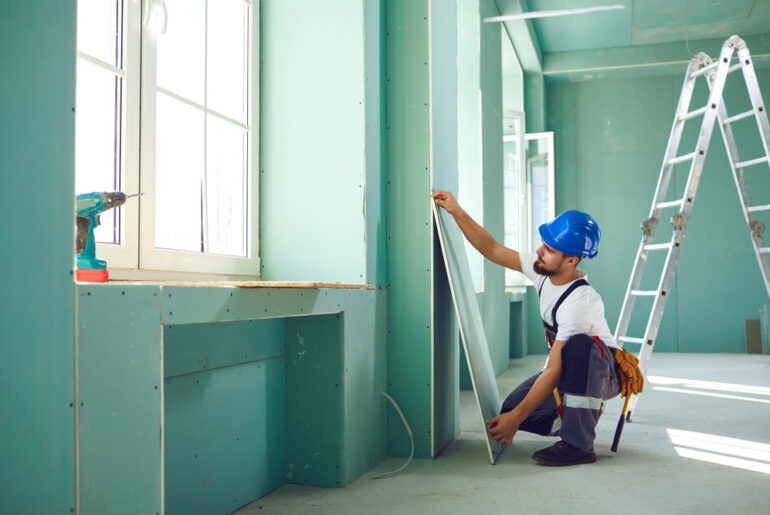Blown in cellulose insulation has been commercially produced and installed in the USA since the 1970s and is one of the most eco-friendly mid-price insulation products on the market today.
It has usually been the preserve of professional installation teams with pricey mobile equipment and bales of material, but it is quickly becoming a popular DIY product too with many home improvement stores able to rent out equipment for hire.
Dense packed cellulose insulation is enjoying renewed interest in the USA largely due to its green credentials and also the fact that its fire-retardant attributes have developed alongside regulatory tightening.
Dense Pack and Loose Fill, What’s the Difference?
Loose fill blown in cellulose insulation has been used for decades to insulate attic spaces. 17 inches will deliver R-60, which covers code in all locations, but with settling over time the R-value may decrease somewhat.
Dense pack cellulose insulation relies on air pressure to deliver insulation to closed areas such as pre-built walls. At a density of 3½ Lbs cellulose should achieve an R-value of 3.8 per inch, which gets pretty close to an R-value of 21 over a 5½ inch depth of wall cavity.
Under Pressure
Due to being installed under pressure, dense packed cellulose is not prone to settling like loose fill. Installed pneumatically via a hose inserted into the farthest reach of a cavity, the blown fiber will find and clog any gaps in the wall, creating a competent air seal.
Very quickly the cellulose will begin backing up around the pipe as it packs into the space. A pull-back and release action by the installer draws the delivery hose back out through the cavity until the entire space is packed solid with no air gaps.
How does it work?
Dense packed cellulose works as an effective air barrier, slowing down movement of air through a building’s thermal envelope to almost zero in some cases. Blower door tests have indicated that up to a third of a building’s air leakage can be stopped after installing dense pack cellulose.
Cellulose and Moisture
Dense pack cellulose insulation does not trap moisture. Even though it is highly absorbent, wicking moisture out of timber wall studs and other adjacent timber structural members, cellulose tends to distribute moisture throughout the cavity, preventing build-up in a single area. This action leads to faster drying and less incidence of mold and mildew.
In fact, manufacturers do not recommend the use of a vapor barrier with dense packed cellulose installations pointing to their understanding that in mild maritime climates most moisture is moved by damp air. When it is prevented from easily moving through a building’s thermal envelope by the density of properly packed in cellulose it ceases to be a problem.
A vapor barrier is only recommended in areas of high rainfall, in pool rooms or spas, and in the most Northerly states or areas with high humidity.
Cellulose and Fire
Cellulose insulation has excellent fire-retardant properties and has a class A rating, which means that they should survive intact for one hour during a fire event. Some manufacturers have developed products that have demonstrated a two- and three-hour firewall capability too. Regular cellulose also boasts a low smoke development index rating, which makes it a very safe insulator.
The magic fire retardant ingredient that is added to cellulose is borate. It also helps to stop the development of mold and mildew, and it puts off insects too. Safe for humans, you can find borate in eye wash and at low trace levels in some food stuffs.
Cellulose and Sound
In a wall with a 4” cavity, dense packed cellulose can deliver an STC rating (Sound Transmission Class) of 41 which should help to cut out most general road noise, due in part to the density of the insulation and also its air sealing properties.
Cellulose and the Earth
Cellulose insulation is one of the most recycled insulation products readily available in stores, behind cotton, and denim fiber products. It is made up of at least 85% recycled paper and cardboard packaging material. Reusing paper for insulation diverts tons of waste material from landfill and is almost an entirely free resource for insulation manufacturers.
You might have read a lot about food-miles, which measure how far produce has to travel to reach your table, likewise a lot of material sourced to manufacture cellulose insulation is oftentimes located locally to the plant. This means that less energy is used to transport either food or material from a place of origin, to its final destination.
Being made up of recycled paper, it also means that cellulose sequesters carbon for the lifetime of the building, which is the capture, removal, and storage of carbon dioxide (CO2) from the earth’s atmosphere.
Embodied Energy
The embodied energy of a product is the measure of how much energy is required in its manufacture. Recycling paper into cellulose insulation takes at least 64 times less embodied energy than foam insulation. It uses ten times less energy to produce than fiberglass, which means that it has almost unassailable green credentials in this respect.
Cellulose has very low VOCs (Volatile Organic Compounds) so there is no risk from off-gassing during or following installation. It is also expected to last at least 75 years in a normal, stable environment.
LEED (Leadership in Energy and Environmental Design) is the most prominent organization promoting green building technologies, and a positive rating from LEED will help you to show off the eco-friendliness of any project. Cellulose scores highly for all of the reasons spelled out above.
Cellulose Pro Installation
Installed from the outside through holes drilled through the external sheathing of a building, the insulation is blown in, fitting around electrical conduits, pipes and ducting creating a solid block of material between wall studs and drywall. Its density helps to limit convection through the wall structure as there is little or no space for air to flow.
What to Expect
For decades cellulose has been installed by professional teams of fitters. They will likely bring a truck to site fitted with a hopper and enough hoses to be able to access right around a building. The siding is removed at a certain height for access to the sheathing, which is drilled out between wall studs.
Once filled the holes are then capped with timber or a plastic stopper before the siding is replaced. The installation team will need full access to the entire external envelope of the building, so you might want to move any planting from beds directly alongside the building.
Blowing any product is a messy business and there may be dust or cellulose residue left on the ground following completion of the works, but it is not toxic and won’t harm plants or animals.
If your home is rendered stucco or brick, the insulation will most likely need to be installed from the inside to reduce making good issues.
Cellulose Costs
An average rate per square foot for a 4” deep wall stud, should come in at about $2 to $2.30 per square foot. Always have at least 5% to 7% in hand for unforeseen issues, such as obstacles inside the wall structure or unusual configurations that the installer would not have been able to price for.
You could save money by getting quotations from local companies during the insulation low season, when you are more likely to be able to negotiate a good discount.
Cellulose DIY
If you are the type to take on any and all tasks your renovation or new build presents then the adventure of dense packing your own walls is possible with many outlets renting blowing machines for use with cellulose. Many come with up to 75 feet of hose and cost from as little as $75 a day.
If you know how deep your wall studs are then it is a straightforward calculation to work out how many bags you will need to do the entire job. Before considering whether or not doing the work yourself is practical, read our guide on how to install dense pack cellulose.





